







The drought situation is still dire in the entire Tsavo Conservation Area. Many of the big herbivores, especially elephants, have been seriously affected by the drought. Several deaths have been reported, and there has also been an increase in calf abandonment. Fodder is increasingly becoming scarce, and many water pans are completely dry. The dry spell is expected to persist for the better part of the year. The Tsavo Mobile Veterinary Unit attended to 19 Cases in September, 12 of these cases involved elephants and 7 cases in total were related to poaching.


The Tsavo mobile Veterinary unit would like to thank all stakeholders who contributed to the success of various interventions they carried out this month. We also wish to thank Vier Pfoten for their on going support through the Sheldrick Wildlife Trust and KWS management for offering technical support.

Date
Species Area Found
Reason for Intervention
Outcome
02 Sep 22 Elephant Kishushe, Tsavo West N.P. Natural Causes Found recumbent near a water hole Died
03 Sep 22 Elephant Lunga Lunga, South Coast Rescue Mother and young calf stuck in a muddy dam Task successful
06 Sep 22 Oryx Kaluku Natural Causes Seen with several injuries all over the body Successfully treated
06 Sep 22 Elephant Athi River Snared Seen struggling to free itself from a snare secured to a tree Successfully treated
07 Sep 22 Zebra Manyani Rescue Found wandering near a zebra carcass believed to be its mother Taken to Orphanage
09 Sep 22 Giraffe Rukinga Conservancy Snared Seen dragging a big tree stump attached to a snare around the neck Poaching Death
10 Sep 22 Giraffe Ishaqbin Conservancy Snared Seen dragging a thick nylon rope snare on its right hindlimb Successfully Treated
12 Sep 22 Elephant Voi Stockades Natural Causes Small stone stuck a few inches from the opening of his right nostril Successfully treated
12 Sep 22 Elephant Taita Saltlick Conservancy Snared Tight winch wire snare around the right forelimb Successfully treated
13 Sep 22 Elephant Maungu Arrow Seen suppurating from the left side of the abdomen Successfully treated
13 Sep 22 Elephant Tsavo East N.P. Natural Causes Struggling to walk Prognosis Poor
16 Sep 22 Lion Tsavo East N.P. Natural Causes Seen with porcupine quills lodged in the head and chest Successfully treated
19 Sep 22 Buffalo Manda Bay Snared Seen walking with difficulty due to a hemorrhaging snare wound on the right forelimb Prognosis Poor
20 Sep 22 Elephant Galdessa Tsavo East N.P. Natural Causes Seen with a swollen left knee and walking with difficulty Successfully Treated
20 Sep 22 Elephant Rukinga Ranch Arrow Swollen suppurating left forelimb Prognosis Poor
21 Sep 22 Elephant Taita Sisal Ranch Rescue Collapsed and attempted to rise severally without success Taken to Orphanage
26 Sep 22 Elephant Manyani, Tsavo Post mortem
26 Sep 22 Elephant Manyani, Tsavo Rescue
Adult female elephant carcass found with a calf, approximately 3 years old, standing close to the dead elephant Died
Adult female elephant carcass found with a calf, approximately 3 years old, standing close to the dead elephant Taken to Orphanage
28 Sep 22 Zedonk Kibwezi Natural Causes Disoriented and occasionally falling over Successfully treated

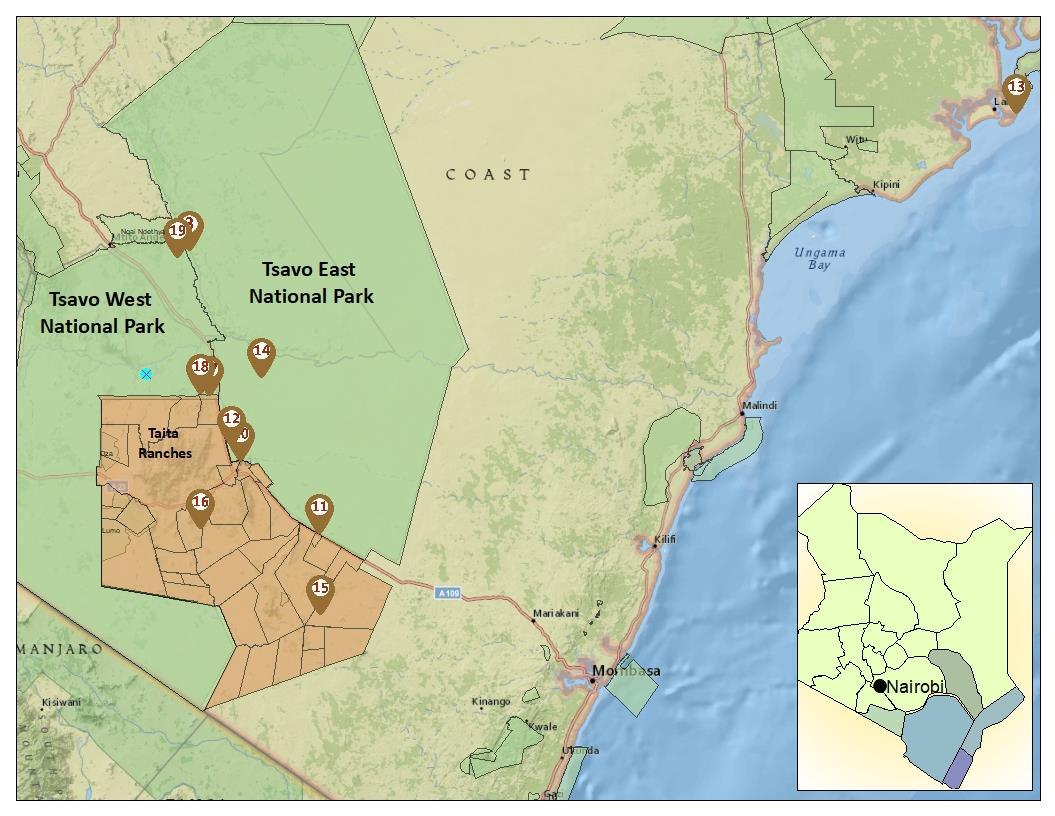
The KWS patrol team found an approx. 4 year old elephant calf recumbent near a water hole in Kishushe area, Tsavo West National Park.
The calf was found on right lateral recumbency, it was dehydrated and emaciated with a body condition score of 1.5 in a scale of 1 5 where 1 is poor and 5 is good. The calf had laboured breathing with a pounding heart.
This was a clear case of starvation due to the current drought. The calf was given ringers lactate intravenous drip with 40 mg Dexamethasone IV. Unfortunately, the calf passed away while treatment was on going. The tusks were removed by the KWS security team onsite, and the carcass disposed of appropriately.

Community members woke up to 2 elephants struggling to free themselves from a muddy dam in the area Local KWS officers and Sheldrick Wildlife Trust were notified 3 days later after it became apparent that the elephant cow and her young calf were not going to be able to free themselves without assistance.
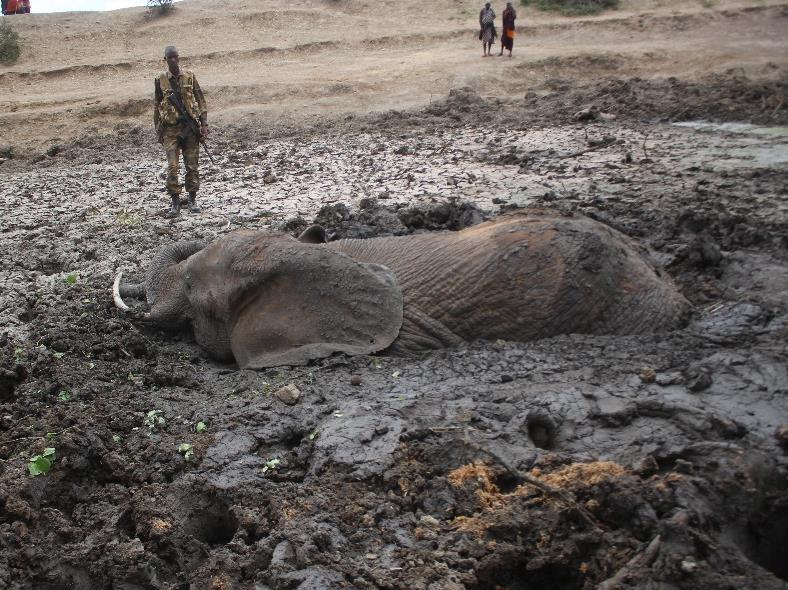

The elephants were found close to each other and stuck in the muddy dam. They appeared exhausted after a long struggle. Community members were providing them with water using buckets.
The team first embarked on pulling the adult female out of the muddy dam since she appeared to be more exhausted by the ordeal. The rescue was a challenge given the sloppy dam edges. Long ropes secured to a vehicle positioned outside the wall of the dam were used to pull the elephant out of the muddy dam.
As soon as the elephant was on firm ground, she was allowed to rest briefly and stand on her own. She rose a few minutes later and dashed to a nearby bush. A tractor was used to pull the calf a few meters from where it was stuck, it stood up almost immediately and run to a nearby thicket.
The mother and calf have a good prognosis and are expected to continue with their lives normally.
A similar rescue involving another elephant cow and her calf was mounted a week earlier in the same dam.
In order to prevent similar occurrences, KWS, Sheldrick Wildlife Trust and county government teamed up to desilt and clean the dam in readiness for the rains.
A semi habituated female oryx rescued several years ago and hand raised at the Kaluku SWT Headquarters was seen with several injuries all over her body. The wounds were consistent with gores from another oryx, a male frequently seen accompanying her was suspected to be the culprit. She had a small calf a few weeks old.


The Oryx had serious injuries all over her body. The wounds inflicted were becoming septic. She appeared to be in severe pain and the lactating calf was dehydrated and emaciated due to decreased milk production from the stressed and injured mother. She was approached on foot and darted with 8mg Etorphine hydrochloride and 80mg Azaperone tartrate. The drugs took full effect after 7 minutes.
Examination revealed multiple septic puncture wounds on the body. The wounds were debrided with Hydrogen peroxide, flushed with water and disinfected with Iodine. Amoxicillin antibiotics and Flunixin meglumine anti inflammatories were administered accordingly. The udder appeared regressed with a small amount of milk being produced on expression.
Anaesthesia was reversed with 24mg Diprenorphine. She rose 2 minutes post reversal and rushed to a nearby bush leaving the calf behind. Given the low milk available to the calf owing to the condition of the mother, the calf was rescued and taken to Kaluku stockades to receive milk supplementation. The mother regularly visits the stockades, and she is expected to interact with her calf freely while he receives milk supplementation.
The oryx has a good prognosis.
Members of a farming community notified the KWS patrol team upon seeing an elephant

itself from a snare secured to a tree.

By the time the Veterinary Unit arrived, the elephant had freed itself. It was believed that a piece of the wire snare was still attached to the animal’s left forelimb. An aerial search for the elephant was therefore requested. The elephant was later found a long distance away from where it was snared. The bull had difficulty walking, and it had a slightly swollen left carpus. The elephant was darted from a helicopter with 20ml Etorphine hydrochloride, and the drugs took effect 8 minutes later. Examination of the limb revealed that the wire snare had fallen off. The limb had snare markings, and it was swollen at the carpal joint. Amoxicillin antibiotics and Flunixin anti inflammatories were administered. Anaesthesia was then reversed with 60mg Naltrexone. The elephant was up 1 minute post reversal and lingered briefly before walking away.


The elephant has a good prognosis.
The SWT KWS de snaring unit found this zebra foal wandering about near a female zebra carcass. The zebra had been knocked down by a vehicle, and it was beliveved that the carcass was the foal’s mother.
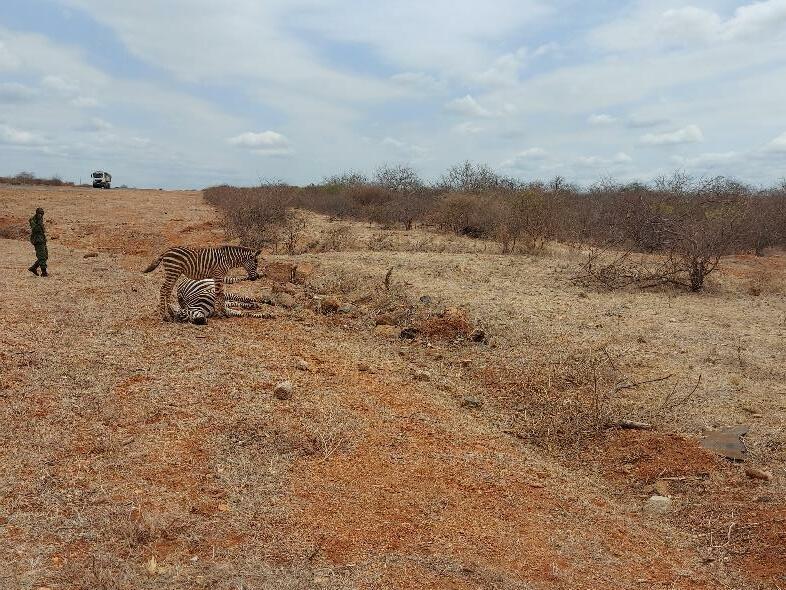
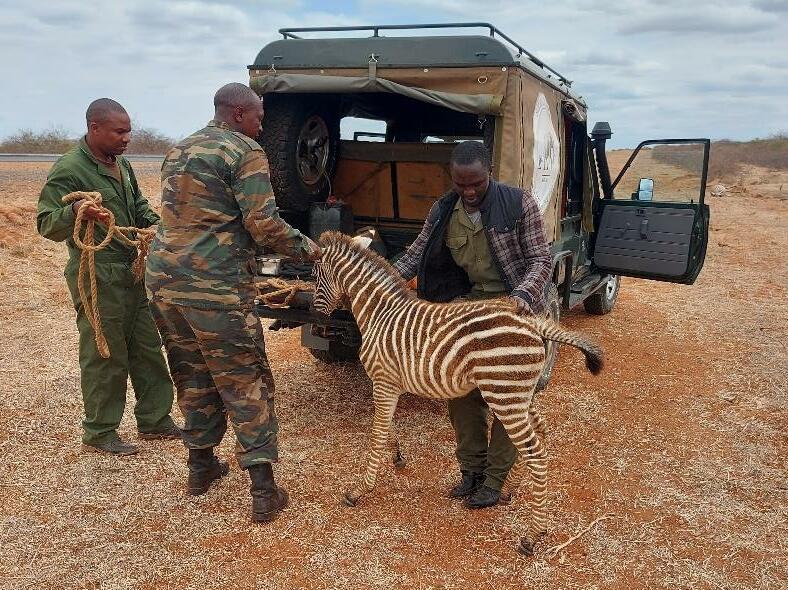
The foal was found standing a few meters from the highway close to its dead mother. The foal was in good body condition, and it was struggling to suckle its dead mother.
The foal was restrained with 1mg Etorphine hydrochloride and 10mg Azaperone delivered in a Dan inject dart. The drugs took full effect after 7 minutes. The foal was captured and taken to the SWT Voi stockades for care and management.
The foal has a good prognosis.
The giraffe was found dragging a huge tree stump attached to a cable wire snare tightly bound around the animal’s neck. The giraffe was in severe distress, and it was struggling to walk and breathe. The giraffe was approached on foot and darted with 13mg Etorphine hydrochloride and 60mg Azaperone. The drugs took full effect after 8 minutes.
The wire was cut off as the giraffe was revived with 48mg Diprenorphine given intravenously. Unfortunately, the cable snare was too tight and strangled the giraffe as it went down leading to a rupture of major blood vessels around the neck and a tear of the trachea as revealed by post mortem carried out after the giraffe passed away

The giraffe was seen by the KWS patrol team and the Conservancy Rangers dragging a nylon rope snare on its right hindlimb.




The giraffe was darted with 12mg Etorphine and 60mg Azaperone titrate. The drugs took full effect after 8 minutes. It was manually restrained, and anaesthesia reversed immediately with 48mg Diprenorphine.
The giraffe was noted to be in good body condition. The thick nylon rope snare on the giraffe’s right hindlimb was cut off. There being no physical injury, the giraffe was released thereafter and ran off to a safe distance.
The giraffe has a good prognosis.


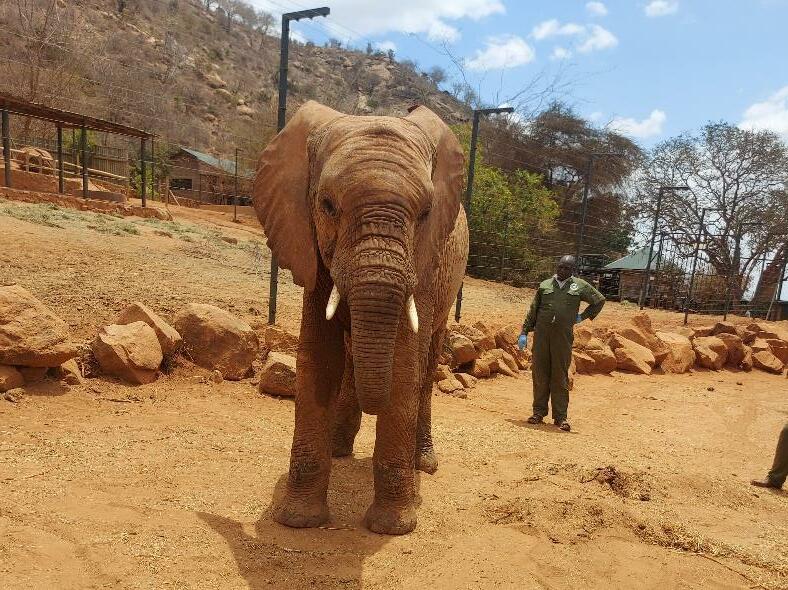
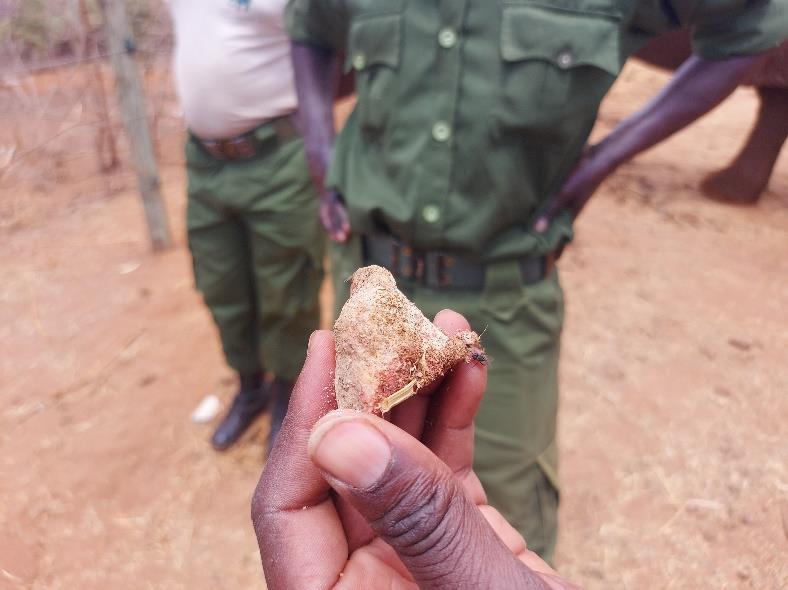
The SWT Keepers at Voi Stockades noted that Ndotto, one of the orphans being rehabilitated at the Voi stockade, had changed his behaviour. He was extending his trunk cautiously and not allowing anyone to touch it. It seemed that he was experiencing pain when using it. Careful observation revealed a small stone stuck a few inches from the opening of his right nostril.
Ndotto was approached on foot and darted with 8mg Etorphine hydrochloride. The drugs took effect 5 minutes later.
Examination revealed a small stone stuck in his right nostril. The stone was grasped with long forceps and carefully removed. Amoxicillin antibiotics and Flunixin anti inflammatories were then administered accordingly. Anaesthesia was reversed with 24mg Diprenorphine chloride and he was up 2 minute later
Ndotto has a good prognosis.
The conservancy rangers saw this calf with a snared swollen right forelimb.

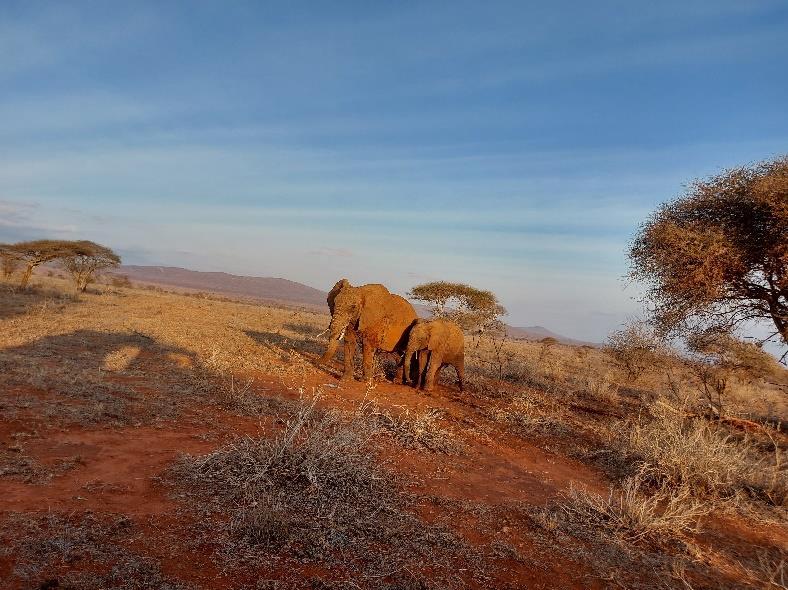

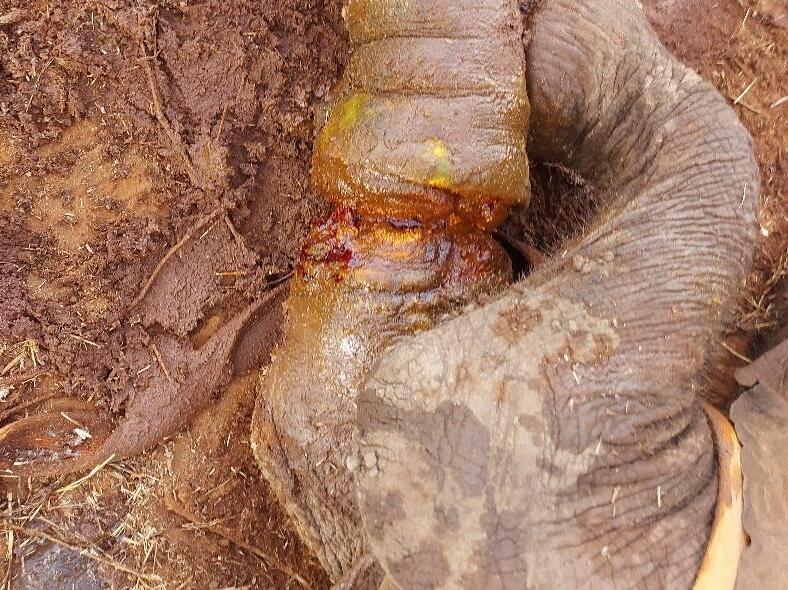
The calf was found with its family numbering 5 individuals. The family was very protective of the calf, therefore the Vet had to immobilize the calf’s mother and elder brother before physically restraining the calf. The tight winch wire snare around the calf’s right forelimb had caused a septic wound. The wire was cut loose then the wound was debrided and flushed with Hydrogen peroxide, cleaned with water and disinfected with Iodine. Green clay was applied onto the wound to enhance healing. Amoxicillin antibiotic and flunixin meglumine anti inflammatories were administered accordingly. The calf was released, and then the calf’s mother and the brother were revived simultaneously. The family was finally re united, and they all walked away together disappearing into the hills in the distance.
The calf has a good prognosis.
The SWT aerial surveillance unit observed this female elephant suppurating from its left lateral side.




The elephant appeared to the matriarch of the family it was found with. The injured female had an old wound with mild purulent discharge on the left lateral side of the abdomen. The matriarch was darted from a vehicle with 18 mg Etorphine, and the drugs took full effect after 8 minutes. The other family members were very protective, so they were gently driven away to allow for the treatment of the matriarch. Examination revealed an old arrow wound which was healing. The wound was cleaned and flushed with Hydrogen peroxide, disinfected with Iodine then Chlortetracycline pessaries were inserted deep into the wound to prevent sepsis. Green clay was applied onto the wound to enhance healing and long acting Oxytetracycline antibiotics and Flunixin meglumine anti inflammatories were administered intramuscularly. Anaesthesia was thereafter reversed with 54mg Diprenorphine given through a prominent ear vein. The elephant rose 2 minutes post reversal and found its way to its family.
The elephant has a good prognosis since the wound was healing.



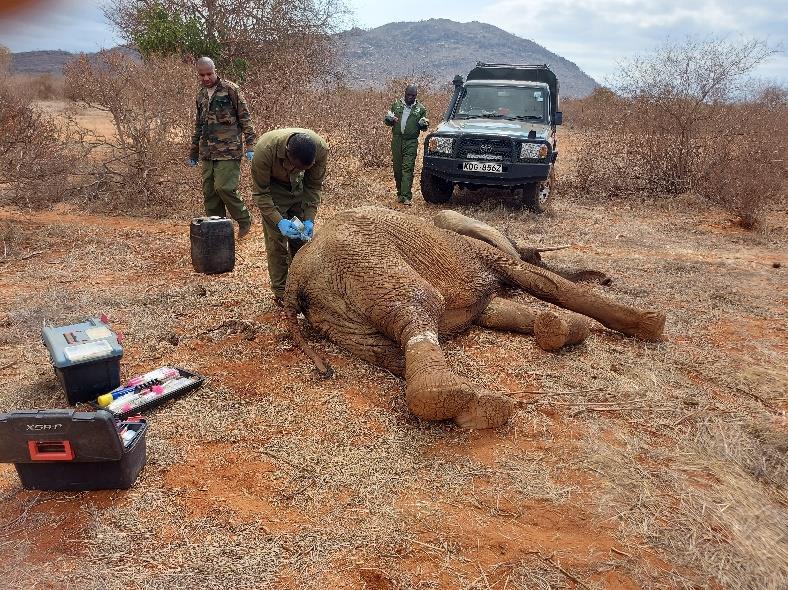
The young bull was isolated from the rest of the herd. It had a swollen right knee and there was some discharge from the swelling. The elephant was darted from a vehicle with 5 mgs Etorphine hydrochloride. It took 7 minutes for the drug to take full effect with the elephant assuming left lateral recumbency upon sedation. Examination revealed a swollen right knee with some bite marks. The wounds were septic with pus accumulating around the joint. All the pus was drained out then the wounds were debrided with Hydrogen peroxide, rinsed with water, disinfected with Iodine and Cloxacillin antibiotic ointment infused. Amoxicillin antibiotics and Flunixin meglumine anti inflammatories were given parenterally. Anaesthesia reversal was achieved with 18 mgs Diprenorphine hydrochloride given through a prominent ear vein. He rose 2 minutes later and moved a short distance away.
The elephant has a guarded prognosis


Tourists in the Park saw this adult male lion with porcupine quills lodged in the head and chest. The lion appeared to be in severe pain.
One porcupine quills was observed in the ventral lower jaw while the other was in the ventral chest region. The lion was darted with 250mg Ketamine and 6mg Medetomidine. The drugs took full effect after 12 minutes.

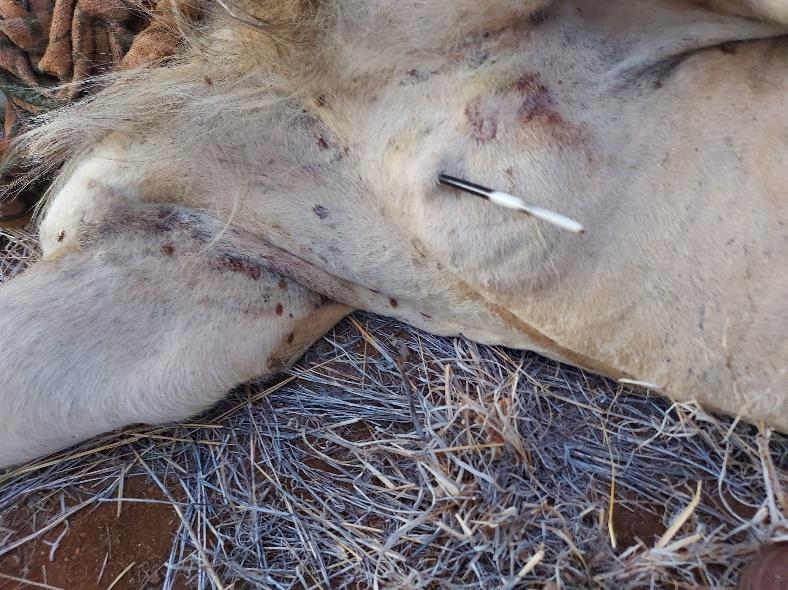
The quills were pulled out leaving out some septic wounds which were flushed with Hydrogen peroxide, disinfected with Iodine and infused with Cloxacillin ointment. Amoxicillin antibiotics and Dexamethasone sodium anti inflammatories were administered accordingly. The lion appeared to be old. Anaesthesia was reversed with 15mgs Atipamezole hydrochloride delivered intramuscularly one hour after immobilization.
The lion has a good prognosis.
Manda bay rangers saw this buffalo walking with difficulty The buffalo had a haemorrhaging snare wound on the right forelimb.


The buffalo was darted from a vehicle with 6mg Etorphine hydrochloride and 60mg Azaperone tartrate The drugs took effect 6 minutes later, and it was placed in a comfortable position for examination.
The buffalo had a tight cable wire snare buried deep into the right metacarpophalangeal joint. Blood was oozing from the snare wound. The wire was cut off and removed then the wound was debrided and flushed with Hydrogen peroxide, rinsed with water, disinfected with Iodine and infused with Opticlox ointment and green clay.
Amoxicillin antibiotics, Flunixin meglumine anti inflammatories and Ivermectin were given parenterally. Supplement pellets were availed as the buffalo had difficulty moving long distance searching for fodder. Anaesthesia was reversed with 24 mg Diprenorphine given intravenously. The buffalo woke up 4 minutes post reversal.
The buffalo has a guarded prognosis
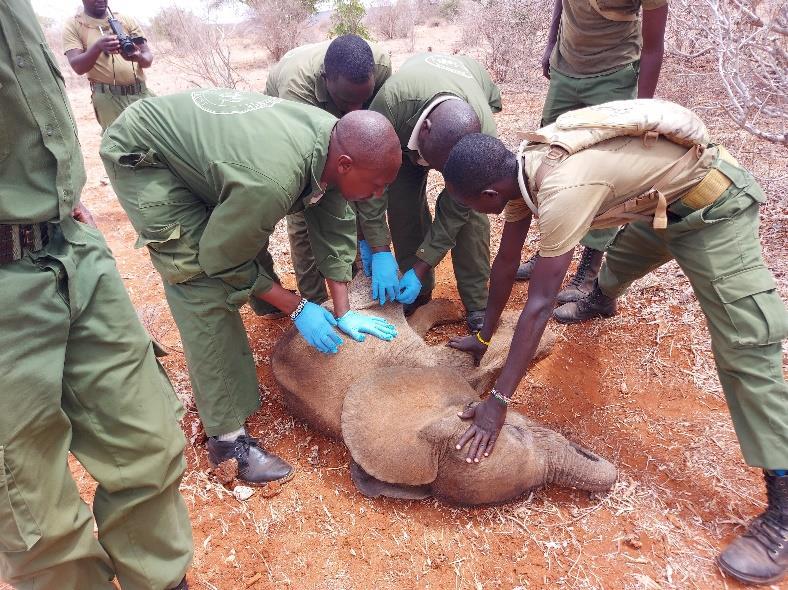
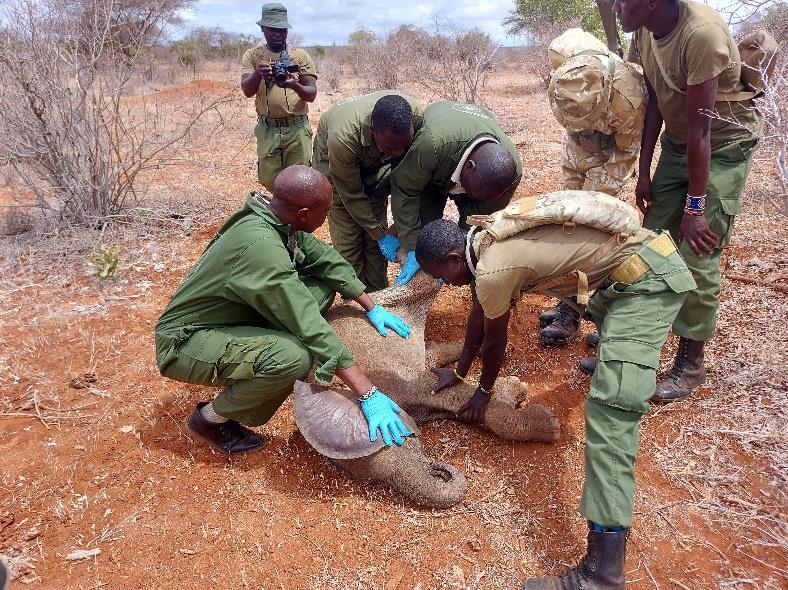


The SWT KWS de snaring unit saw this elephant calf with a swollen left knee having difficulty walking. The calf was accompanied by its family.
The calf was in poor body condition with an estimated score of 2 in a scale of 1 5, where 1 is poor and 5 is good. The calf’s mother was very protective, and she had to be chemically restrained with 18mg Etorphine hydrochloride for the veterinary unit to assess the calf.
The calf was physically restrained, and examination showed an old injury that had healed. The injury was suspected to have damaged the joint which healed with a deformity. This could have been caused by attempted predation by lions. No treatment was given. The calf’s mother was revived, and the family was re united. The calf will live with the deformity, and it is expected that it will overcome the mobility challenges as it grows.
The elephant calf has a good prognosis.
Wildlife Works rangers saw this elephant with a swollen suppurating left forelimb.



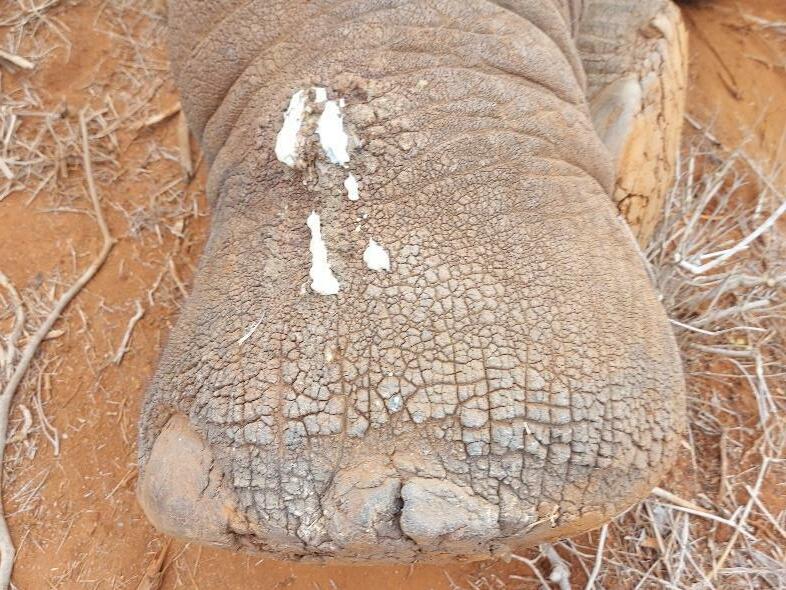
The bull elephant had difficulty walking and favoured the left forelimb. A septic wound was observed at the carpus of the left limb. The elephant was darted from a vehicle with 19mg Etorphine hydrochloride. The drugs took full effect after 11 minutes with the elephant assuming sternal recumbency. The bull was repositioned to lie on its right side for comfort and ease of assessment and treatment. Thorough probing of the wound yielded an embedded poisoned arrow causing severe necrosis of the tissues around the joint. The wound was debrided and flushed with Hydrogen peroxide, rinsed with water and disinfected with Iodine. Green clay was then packed into the wound to enhance healing. Amoxicillin antibiotics and flunixin meglumine anti inflammatories were also administered intramuscularly. Anaesthesia was reversed with 48mg Diprenorphine, and 40mg Naltrexone given through a prominent ear vein. The bull rose after 2 minutes and walked slowly towards an elephant herd drinking water nearby.
The elephant has a guarded prognosis.
The sisal ranch management informed the Veterinary Unit that this elephant calf had collapsed and attempted to rise severally without success. This happened when the calf and her family went to drink water at the ranch.

The calf was found in right lateral recumbency. She was emaciated and in poor body condition. Although she was alert and active, the calf was very dehydrated and had an enlarged abdomen. Due to dehydration and observed lethargy, fluid therapy was indicated. Ringers lactate solution was infused intravenously through a prominent ear vein. 10% Dextrose solution was also administered intravenously.


The vet’s assessment showed this calf could not make it in the wild even though her mother was close by. The calf was rescued and airlifted to the SWT Nursery in Nairobi.
The elephant calf has a poor prognosis since she was too weak and very emaciated.

During a routine patrol, the KWS security team saw this adult female elephant carcass. A calf, approximately 3 years old, was also seen standing close to the dead elephant

The calf was found standing close to her dead mother that died less than 24 hours earlier. The mother was emaciated with a body condition score of 2. Generalised icterus was observed on the mucus membranes with oral laceration. There was purulent anal rectal discharge, and the abdomen was swollen. There was chronic generalised peritonitis with massive adhesions of the peritoneal organs. Large amount of straw coloured fluid was seen in the peritoneum. Pus had accumulated within the peritoneal cavity with petechiae on surfaces of most of abdominal organs. Additionally, a penetrating traumatic anorectal puncture wound that communicated with the peritoneal cavity was also observed.
The immediate cause of death was septicaemic shock. The anorectal puncture penetrated deep into the peritoneal cavity. The cause of the puncture could not be established, but it was thought to have been caused by another elephant’s tusk. This caused a fistula between the gastrointestinal system and the peritoneal cavity causing peritoneal contamination and chronic peritonitis leading to death of the elephant. The condition was further complicated by the pregnancy stress given the mother was carrying a 1.5 year old male foetus. The 3 year old female calf who seemed to have been very much attached to her mother was rescued and taken to the SWT Nairobi Nursery for care.


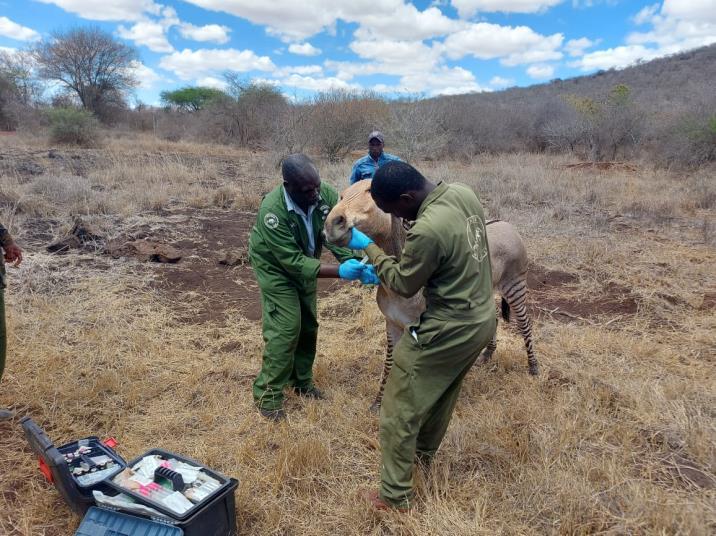
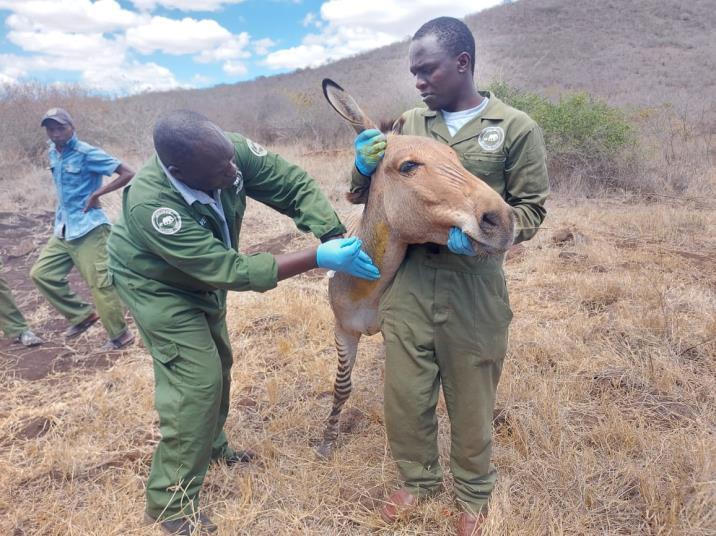
This zedonk foal, the offspring of a common zebra female and a domestic donkey stallion, lives in Kibwezi Forest Reserve The zedonk’s mother was rescued from a community area after having lived with domestic animals. At the time of rescued, the zebra was expectant and gave birth to zebra/donkey cross. In the morning, SWT staff based in Kibwezi Forest saw the zedonk foal disoriented and occasionally falling over.
The zedonk was weak and found in lateral recumbency. It appeared disoriented when helped to stand and move. It also displayed head pressing tendencies with poor masticating abilities. Complete physical examination was carried out and its state was tentatively considered to be an acute but mild nervous condition. Acute brain oedema from a concussion was suspected to have caused the zedonk’s condition The foal was given a slow intravenous Dexamethasone sodium anti inflammatory injection to relieve pain and reduce swelling, Ivermectin parasiticide to control both internal and external parasites, Oxytetracycline antibiotics and Butasal to help boost muscle and nerve activities.
The foal has a favourable prognosis and is expected to regain her health. It was expected that the foal’s transient oedema will subside with time